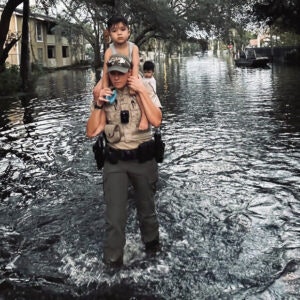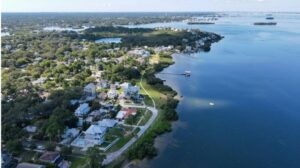Wildlife Foundation Grant to Fund Nature-based Plan for Flood Adaptation

June 13, 2025
By Vicki Parsons
A $1.99 million grant from the National Fish and Wildlife Foundation will allow the Tampa Bay Regional Planning Council (TBRPC) to develop a Coastal Master Plan that helps to prepare the region’s most vulnerable communities for climate change and associated flooding by emphasizing nature-based solutions.

More than 100 people attended the launch workshop held May 30, which featured speakers from across the region as well as from Louisiana and Virginia, where statewide coastal master plans have been developed. The Tampa Bay region has been identified as the most vulnerable area in the US to storm surge, and half of the region’s population lives at elevations below 10 feet, making flooding a common problem even without a major storm.
“We recognize that we can’t prevent flooding in events like the 2024 hurricanes,” said TBRPC Chair Maureen “Moe” Freaney, mayor of Dunedin. “The goal with this grant is to create a regional plan that reduces flooding in vulnerable neighborhoods and builds resiliency into coastal and riverine habitats by emphasizing nature-based solutions.”
Multiple governments and agencies are developing flood mitigation plans to protect vulnerable communities, but they rarely consider nature-based solutions and are not implemented as part of a larger, data- and community-driven plan, notes Alana Todd, TBRPC’s principal environmental planner and project manager for the Coastal Master Plan.

The four-year initiative will catalyze the implementation of nature-based flood risk reduction projects, pinpointing places where targeted investments can deliver the most important benefits for communities and habitats. The final plan will illustrate flood risks for the region’s vulnerable areas, proposing a coordinated suite of restoration initatives and structural and nonstructural flood reduction projects. The plan will also include an interactive dashboard to help communicate current and future flood risks, as well as the project concepts..
The Coastal Master Plan will cover seven counties, including Citrus, Hernando, Pasco, Pinellas, Hillsborough, Manatee, and Sarasota Counties. More than 40 partners are part of the effort, including:
- The Tampa Bay Estuary Program will conduct a habitat vulnerability assessment and then leverage its Habitat Master Plan to identify potential sites and habitat types that could be integrated into nature-based projects.
- The Jacobs Public Interest Law Clinic for Democracy and Environment at Stetson University will identify non-structural measures to improve resilience, then identify funding opportunities to implement recommendations.
- The National Wildlife Federation will coordinate public outreach with stakeholders across the region. To promote equity and inclusivity, the plan will prioritize engaging historically underserved and underrepresented communities.
- The University of Florida will host workshops throughout the region for community-based organizations and local government staff to learn community engagement strategies, including facilitating community conversations about flood risk and deliberative discussions about project concepts.
“This will be the first comprehensive regional master plan in the state to look at flood reduction projects by bringing together multiple stakeholders from across our 4,400-square-mile region,” notes Wren Krahl, TBRPC’s executive director. “It was a highly competitive bidding process from one of the nation’s most prestigious foundations supporting efforts to enhance habitats for fish, wildlife and plants.”
To learn more about the Tampa Bay Coastal Master Plan, visit CoastalTampaBay.org
